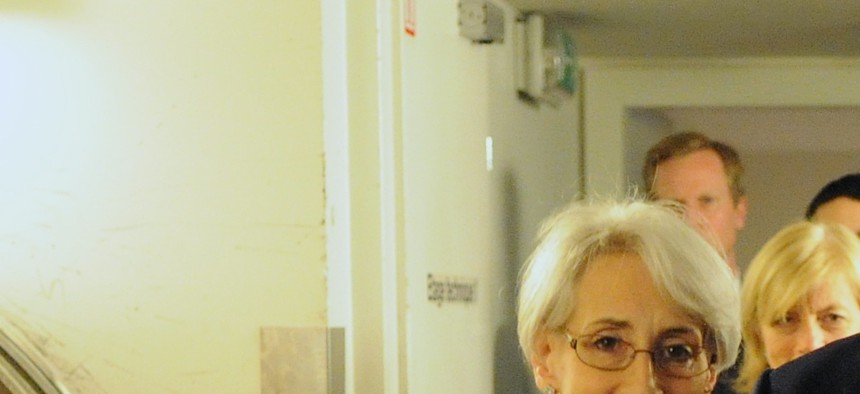
Secretary of State John Kerry with Under Secretary of State for Political Affairs Wendy Sherman after the P5+1 reached a nuclear deal with Iran in Geneva, Switzerland, Nov. 24, 2013. State Department Photo
The Deal is for Real
No president since Jimmy Carter has been able to make a deal with Iran. Barack Obama just did. By Joe Cirincione
Every president since Jimmy Carter has tried to make a deal with the Islamic Republic of Iran. None have succeeded. President Barack Obama just did. The deal to limit and begin to roll back Iran’s nuclear program may be the most important foreign policy success of his tenure.
It starts with a single step, and it is an important one. The first phase of the agreement just reached in Geneva makes it much more difficult for Iran to dash for a bomb. It also begins to lock down the nuclear program that has plagued United States officials for over ten years.
When Israeli Prime Minister Benjamin Netanyahu drew his red line across a cartoon drawing of a bomb at the United Nations in September 2012, he was talking about Iran's ability to enrich uranium to near-bomb grade. If Iran enriched enough uranium to 20 percent purity, Netanyahu warned, it would take only “a few months or a few weeks” to turn it into the core of a bomb. “That’s why I speak today with a sense of urgency,” he said, “That’s why everyone should have a sense of urgency.”
The deal Secretary John Kerry masterfully crafted in Geneva eliminates the threat Mr. Netanyahu said was his most serious concern. It completely stops the enrichment of uranium to 20 percent. It gets rid of all the uranium Iran had already enriched to this level. As a result, it doubles the time it would take Iran to dash to a bomb, plus it adds tough new daily inspections of the nuclear facilities that could spot any such dash, giving nations ample time to take appropriate actions.
But wait, there’s more. The deal basically freezes the Iranian program in place. It is not a complete suspension, but it makes sure that Iran cannot move ahead with its program while negotiations continue.
The first phase of the deal prohibits the manufacture or installation of any new centrifuges. It requires that any new low-enriched uranium produced be converted to an oxide form that cannot be used for a bomb. It halts any major new work on the Arak reactor, a possible source of plutonium that could be used for a bomb. It opens up facilities that had been previously closed to inspectors from the International Atomic Energy Agency. In exchange, the other nations will deliver about $7 billion in sanctions relief, leaving the entire sanctions architecture in place and continuing to freeze over $100 billion in Iranian assets held abroad.
This is just the initial phase. If Iran wants serious sanctions relief and access to those frozen billions, it will have to negotiate over the next six months a final agreement that would permanently cap Iran's capabilities and permit extensive inspections that can verify these limits and assure that there are no secret nuclear facilities. In short, the final deal will ensure that Iran cannot build a bomb and if it tried to do so, would be quickly caught.
The deal has been met with broad approval in all of the nations involved in the negotiations. When all parties leave the table declaring victory and return home as heroes, it is the sign of a deal that can endure.
Most serious U.S. security officials welcomed the deal. Former national security advisors Brent Scowcroft and Zbigniew Brzezinski wrote to Congress last week, urging a pause in any new sanctions as the deal, “would slow crucial elements of the Iran program, make it more transparent and allow time to reach a more comprehensive agreement in the coming year...Such an agreement would advance the national security of the United States, Israel, and other partners in the region.”
Former Secretary of State Madeleine Albright joined with her own letter to Congress and then organized an appeal by former foreign ministers from 13 nations who believed “it makes sense to commit to intensive negotiations with Iran while Iran freezes its nuclear enrichment program.” The Iran Project headed by Amb. Tom Pickering and Amb. Bill Luers earlier released a letter from 79 former officials and security experts, including Ryan Croker, Wendy Chamberlin, Joseph Nye, Anne-Marie Slaughter and Frank Wisner, in support of the negotiated deal.
Opposition to the deal is confined to the leaders of Israel, Saudi Arabia, some other Gulf states and a small minority of politicians and experts in the United States. There are no senior voices opposed to the deal that compare to the stature or experience of those favoring the process. Meanwhile, polls show huge majorities of Americans in favor of a deal, with 64 percent in support according to a Washington Post survey.
Part of the reason may be the broader potential for the deal. In just the past three months, there have been breakthrough agreements that are eliminating the chemical weapons of the brutal Assad regime in Syria, and limiting a program that could produce nuclear weapons in Iran.
Most experts thought both impossible. Now, as the head of the Carnegie Endowment’s Moscow Center Dmitri Trenin tweeted: “Iran nuclear deal, Syrian CW disarmament usher in wholly new dynamic in MidEast. Need to be sustained. US-Rus-EU-China cooperation key.”
Indeed, such cooperation is already underway. Foreign Policy’s Colum Lynch reported that even as negotiators were hammering out the final wording of the Iran deal, officials from the United States, Iran, Russia and Saudi Arabia and others in Geneva “held secret and informal meetings on Thursday to devise a strategy of improving the U.N.’s stalled relief effort in Syria.” Again, the idea that the U.S. and Iran could meet to discuss Syria was beyond the pale two months ago. Now, it is the new normal.
It is possible that the nuclear deal and these related efforts could lead to a broader rapprochement with Iran that could, in Iranian President Hassan Rouhani’s words, help the U.S. and Iran "manage our differences." Not "resolve" them; not "overcome" them, but more pragmatically manage them the way U.S. officials managed differences with China under Nixon and Russia under Reagan. The United States could get Iranian cooperation on a score of key U.S. strategic issues including Iraq, Afghanistan, Al Qaeda, Syria and the Israel-Palestine peace process.
More broadly, rolling back the Iranian program removes the largest perceived nuclear proliferation threat. Although there is no logical connection between the 5000 nuclear weapons in the U.S. active nuclear arsenal and the possibility that Iran might someday get one or ten, psychologically and politically there is.
If Iran were to become a nuclear-armed state it would be much more difficult to negotiate reductions in global stockpiles. Eliminating this threat creates the security conditions necessary for nuclear-armed states to consider reducing obsolete arsenals and for threshold states to refrain from beginning new programs.
Coupled with the success of the agreement to destroy Syria’s chemical weapons arsenal, the negotiations are a dramatic example of the efficacy of diplomacy in resolving the most difficult of security problems.
It’s the real deal.
Joe Cirincione is president of Ploughshares Fund and the author of Nuclear Nightmares: Securing the World Before It Is Too Late.




